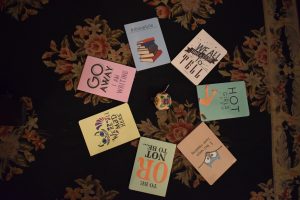Journaling is a great tool for self-discovery and personal expression. However, bonding through journaling with your child is another insightful offshoot of the process.
CONNECT is an organization that aims to reconnect an individual to his or her emotional core. Dr. Priyanka Tibrewala, a certified EQ Coach and Parent Mentor heads the organization. She has conceptualized and written the “Twin Hearts Journal” especially curated for parents and children. In short, it facilitates bonding through journaling.
Bookedforlife chats with her to know more….
As a part of your organization CONNECT, do you often use journaling with your clients?
Yes, CONNECT is a platform for every child, every adult and every individual to grow and to self-develop. In this process, knowing yourself, understanding your feelings, your motivators and your habits, plays a very crucial role. Journaling is a powerful tool to assist one in this process of self-discovery. Only once we are aware of what we want to change and where we want to reach, can we actually start the process of positive change. Journaling is used with most coaching clients to support their positive change.
The “Twin Hearts: Mom n Me” journal aims to foster bonding through journaling. Can you tell us about the genesis of this idea of using journaling as a tool for bonding?
As parents, we want to transfer and inculcate so many positive values, characteristics, attributes, skills, and thought processes in our children. It becomes difficult to really pinpoint and focus on the select few which are the most important. At the same time, many of us do not really know how to spark real conversations with our kids that will bring out our vulnerability, our past experiences, our stories.
So many of our golden stories remain buried somewhere in our memory bank. Only when there is a written or verbal prompt that forces us to dig those out, do they come alive. So, through this journal, we are making it simple for parents and children to exchange feelings, ideas, experiences. They simply both write about a particular question on a page and that sparks a conversation most of us have never even had. But we realize how fulfilling it is and how connecting it is. So, the more we really engage with each other, the more connected we become. This journal is that tool to help you rekindle and deepen the bond we always wish to have with our kids.

I am curious to know why it’s for mothers and children. Why not fathers and kids?
It is actually designed in a way that either parent can use it to interact with their children. However, most children tend to communicate and express more freely to mothers. So once the child has experienced how joyful it is to journal with the mom, then the child will actually be excited to replicate the same with his father and know about his or her father so much more.
The journal has questions for both the parent and the child. It is to be done together. What is it that you want the duo to achieve once they are through with the entire process of following the journal? How will the relationship have evolved?
Yes, the journal is an active process that the parent and child co-create. The objective is to spark connection, communication, moments of trust love and joy through understanding each other more, knowing each other’s dreams more, knowing what we are looking forward to more, knowing each other’s memories more. The relationship will significantly deepen when the two consciously engage in thinking about, writing, and discussing the prompts given on each page of the book.
Do you use this journal as a part of your therapy and coaching or can users buy it separately?
Yes, this journal is a part of our Family 2.0 program to support families to enhance their family bonding and strength. Users can also buy it separately online as an eBook or a hard copy version. It is a beautiful gift to give any child as it will be a collection of precious moments for that child for a lifetime. A treasury of memories.
What are your tips for making the journaling experience more fruitful for the parent and child?
This experience should be enjoyable, fun, something to look forward to. The parent and child should wait to read what the other has written. So, do not pressurize your child and make it like a homework activity. As a parent, be honest and transparent in your answers, and allow the child to freely express whatever they feel for that question. It is about knowing, not correcting.
What age group is the journal apt for?
Any child between the age of 6 and 14 years.
Once a parent-child duo has completed the journal, what’s the next step? How can they take this experience further?
The next step is to create a structure for family bonding experiences. If we can create an easy to do structure of what we want to do and how we want to do it, so our family remains connected and strong, it will make us worry free. We will not have to worry about the teenage years, and then college years, and further beyond. We will know we have a system in place that ensures clear communication and fosters deep connection between you and your child.
At our Family 2.0 program, we work with families to experience and create such a structure, that will help them for a lifetime!
More stories on journaling? Click here



